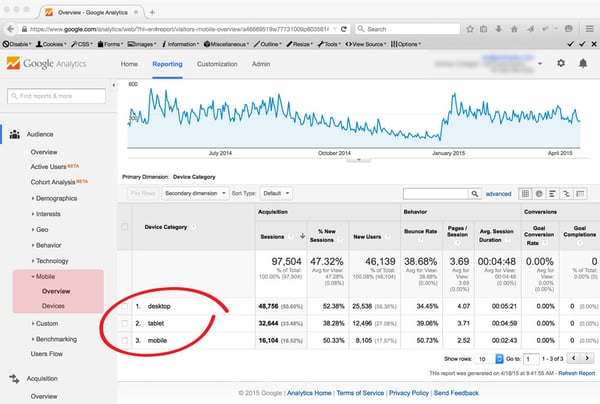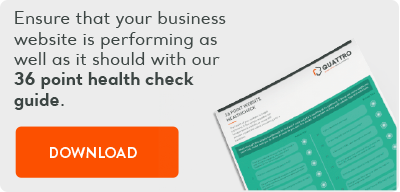With the announcement that Google mobile search will favour websites optimised for mobile devices, it’s easy to panic and make the wrong decisions in an attempt to make your desktop website mobile ready.
There’s a lot at stake, lost visitors to your website means lost customers and lost customers means lost revenue.
If you manage or own tourist attractions in Warwickshire or the surrounding areas this is particularly relevant to you. An increasing number of your visitors, if not the majority, will find and source information about your attraction on a mobile or a tablet. Your business is also seasonal so the Google mobile update is not well timed as we approach the beginning of the busy bank holiday season.
Will mobile users be able to find your website in mobile search results?
To help you through this, we’ve compiled a list of tips to help you work out what affect Google’s algorithm update will have on your business, what immediate steps you can take to offset the immediate loss of visitors and longer term suggestions to get your website back on track.
Tip 1. Don’t make hasty decisions and rush into a responsive upgrade for your website.
The worst thing you can do is to rush an update to your website and react to Google’s algorithm change with haste. Yes you will see your website slip in mobile search results if it’s not mobile optimised, but a poorly thought out mobile site will do more damage to your search engine positioning than keeping your existing desktop site.
Tip 2. Assess the impact on your business
Ultimately you will need to make your website responsive there’s no getting around this, but knowing what immediate impact Google’s update will have on your business will give you a guide to the timescales in which you need to make the change.
Here’s the science bit.
If you have Google Analytics installed on your website (and you definitely should) have a look at your visitor stats. What you want to discover is how many of your visitors browse your site on mobile devices.
Log in to A, select the ‘Audience’ section on the left menu bar and then select the ‘Mobile’ and ‘Overview’ options. On the right hand side of the screen you will see how many visitors browsed the site on mobile or desktop. To get an accurate analysis of your audience’s behaviour, you need a decent sample period; I’d recommend a year. Navigate to the top right hand corner of your screen and adjust the sample period to start this time last year and the end period to today.

Select a longer sample period for more accurate data.

All the intelligence you need to make an informed decision about mobile usage can be found in the audience section of Analytics.
If, as in the example illustrated you have tablets and mobiles listed in the device category, add the numbers for each of these together as they are both regarded as mobile devices by Google and are both served Google’s mobile search results.
There are three key sections within the results to consider, sessions, new users and bounce rate. From these sections you can determine how many sessions or new users browsed your site from mobile devices and from that you can assess the impact on your businesses.
Here’s an example of how to use the data
Think about how your website serves your business. What’s more important, new visitors or repeat visitors? If you sell one-off items, new visitors will be your focus, if you sell repeat purchases then you’ll be focused on returning visitors. If you own or market a tourist attraction the split will likely be 70/30 new/returning or similar.
In the example illustrated, 44.57% of new users browse this site on mobile devices. This is a business which, is heavily focussed on new visitors, so in real terms 44.57% represents 9,974 new potential customers annually.
The bounce rate for mobile users to this site is 89.79%. So 9,974 potential customers browsed the site, but 8,955 bounced away because it wasn’t optimised for their devices. That’s a lot of lost customers. In Google's latest mobile update this user behaviour will be tracked and will influence the sites mobile search positioning.
There's definitely a case here to update the site to a mobile friendly version.
Tip 3. Don’t get overwhelmed and get planning.
It’s easy to get overwhelmed by the data in analytics, but remember the goal here was to determine what initial impact this change will have on your business. Now that you’ve established this, get planning. Once you’ve got a plan of action you’ll feel better and will make better decisions.
Here’s an example action plan
Create a timing plan
A typical responsive website will take three months or more to plan, design, build, optimise and transition to. It is unlikely that your existing website can be upgraded to become responsive, so it’s always better to base your plan on a website rebuild. Create a timing plan with this in mind. Set a desired completion date and work backwards from that.
Establish if you need take any interim actions
Can your business wait three months or more for a new website? If the potential damage to your business will be significant, think about some interim steps you can take to alleviate this impact while you build your new responsive website.
For tourist attractions about to face the UK bank holiday season, interim steps are absolutely essential.
Here are some interim steps for you to consider
- Create targeted mobile optimised landing pages for key products, services or offers
- Consider a mobile optimised blog
- Create a responsive micro site, this could be just 2 or 3 pages
Development time for each of the these will be significantly less than that of a full website rebuild and you will quickly see a return on your efforts in terms of visitor numbers and search positioning.
One thing to bear in mind, is that interim steps are just that. They will get you through the peak holiday season, but as your competitors raise their game in response to Google’s update, you will need to as well. Revisit the timing plan and start planning the responsive rebuild of your site, don't wait until the low season to start it.
Think about budget and resources
Have you got enough funds in your marketing budget to cover the cost of a responsive web design? Alternatively, are interim actions more affordable this year ahead of a rebuild next year? Who are you going to use to design and build the site, to copy-write and project manage it. Answers to these questions will inform your decision making.
Draw up a site map
Site maps are hugely valuable in the management of any website, as they give you a clear overview of the structure and content of your entire website. You can use this data to help you determine which areas of the website you should focus your attention on first. This is especially important if you're considering interim actions.
Ahead of a website rebuild the site map will help you visualise the extent of the task and help you develop a brief for the new site.
If you have access to an old site map for your current website this is a great place to start. If not, start drawing one up.
Benchmark key metrics in Analytics
It is important that you monitor the effect the algorithm change has on your business over time. Select some key metrics in Analytics, like visitor numbers, new versus repeat visitors and device usage and monitor these figures month on month until you put your action plan in place.
Final thought
With careful planning and decision making, backed up by real user data, you will be on your way to getting your website back on track. Interim steps for many tourist attractions in Warwickshire will be sufficient to stem the loss of visitor numbers, ahead of more comprehensive actions out of season.
If you found this blog 'Google Mobileggedon 3 tips for Tourist Attractions in Warwickshire' useful you may be interested in Google mobile update hits tourism industry hard: advice for attractions





